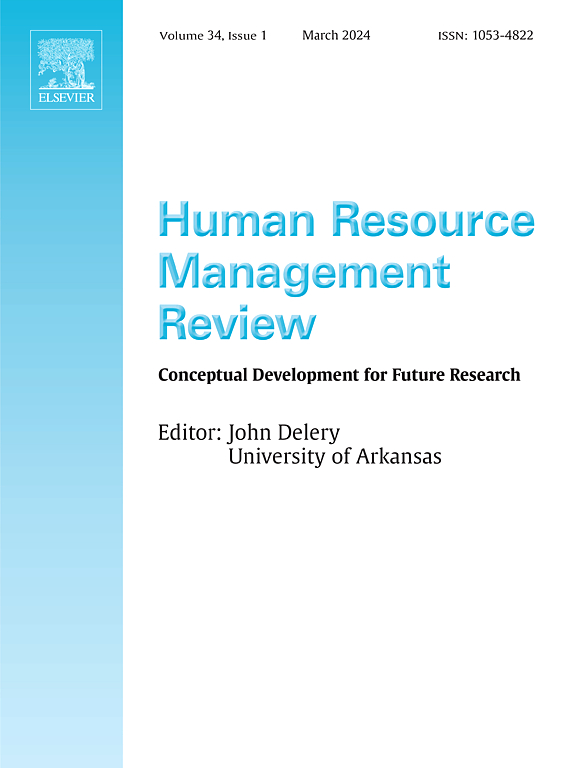团队沟通行动:超越团队中面对面与虚拟互动的二分法
IF 13
1区 管理学
Q1 MANAGEMENT
引用次数: 0
摘要
在本文中,我们介绍了团队沟通行为的新概念,它反映了团队成员在沟通媒体上执行的行为,塑造了他们彼此互动的方式,例如使用书面信息或涉及多个参与者。这个新概念提供了对团队内部通信媒体使用的更细粒度和细致入微的理解。现代团队通过多种媒体进行互动,将信息和通信技术(ict)与面对面互动相结合。然而,对信息通信技术的研究往往与表现出某种程度的虚拟性的团队联系在一起,而忽视了各种团队对信息通信技术的广泛使用。此外,这项研究经常采用信息通信技术与面对面互动的二分法,将所有信息通信技术归为一类,而忽视了它们的独特功能。团队沟通行动的想法通过将相关的计算机媒介传播理论(如媒体同步性理论和技术的非确定性理论)与团队文献相结合,可以解决这些限制。为了实现这一点,我们还列出了八种不同的沟通行为,并分析了这些行为如何影响几个团队合作过程。本文章由计算机程序翻译,如有差异,请以英文原文为准。
Team communication actions: Beyond the dichotomy of face-to-face versus virtual interactions in teams
In this article, we introduce the novel concept of team communication actions, which reflects the actions that team members perform over communication media, shaping the way they interact with each other, such as using written messages or involving multiple participants. This new concept offers a more fine-grained and nuanced understanding of the use of communication media within teams. Modern teams interact through multiple media, combining information and communication technologies (ICTs) with face-to-face interactions. However, the study of ICTs is often associated with teams that exhibit some level of virtuality, overlooking the extensive use of ICTs by all kinds of teams. Additionally, this research has often adopted a dichotomous perspective of ICTs versus face-to-face interactions, grouping all ICTs together and ignoring their unique capabilities. The idea of team communication actions allows these limitations to be addressed by integrating the ideas of relevant computer-mediated communication theories, such as Media Synchronicity Theory and non-deterministic theories of technology, with the teams literature. To achieve this, we also present a list of eight different communication actions and analyse how these can impact several teamwork processes.
求助全文
通过发布文献求助,成功后即可免费获取论文全文。
去求助
来源期刊

Human Resource Management Review
MANAGEMENT-
CiteScore
20.20
自引率
7.00%
发文量
0
审稿时长
48 days
期刊介绍:
The Human Resource Management Review (HRMR) is a quarterly academic journal dedicated to publishing scholarly conceptual and theoretical articles in the field of human resource management and related disciplines such as industrial/organizational psychology, human capital, labor relations, and organizational behavior. HRMR encourages manuscripts that address micro-, macro-, or multi-level phenomena concerning the function and processes of human resource management. The journal publishes articles that offer fresh insights to inspire future theory development and empirical research. Critical evaluations of existing concepts, theories, models, and frameworks are also encouraged, as well as quantitative meta-analytical reviews that contribute to conceptual and theoretical understanding.
Subject areas appropriate for HRMR include (but are not limited to) Strategic Human Resource Management, International Human Resource Management, the nature and role of the human resource function in organizations, any specific Human Resource function or activity (e.g., Job Analysis, Job Design, Workforce Planning, Recruitment, Selection and Placement, Performance and Talent Management, Reward Systems, Training, Development, Careers, Safety and Health, Diversity, Fairness, Discrimination, Employment Law, Employee Relations, Labor Relations, Workforce Metrics, HR Analytics, HRM and Technology, Social issues and HRM, Separation and Retention), topics that influence or are influenced by human resource management activities (e.g., Climate, Culture, Change, Leadership and Power, Groups and Teams, Employee Attitudes and Behavior, Individual, team, and/or Organizational Performance), and HRM Research Methods.
 求助内容:
求助内容: 应助结果提醒方式:
应助结果提醒方式:


